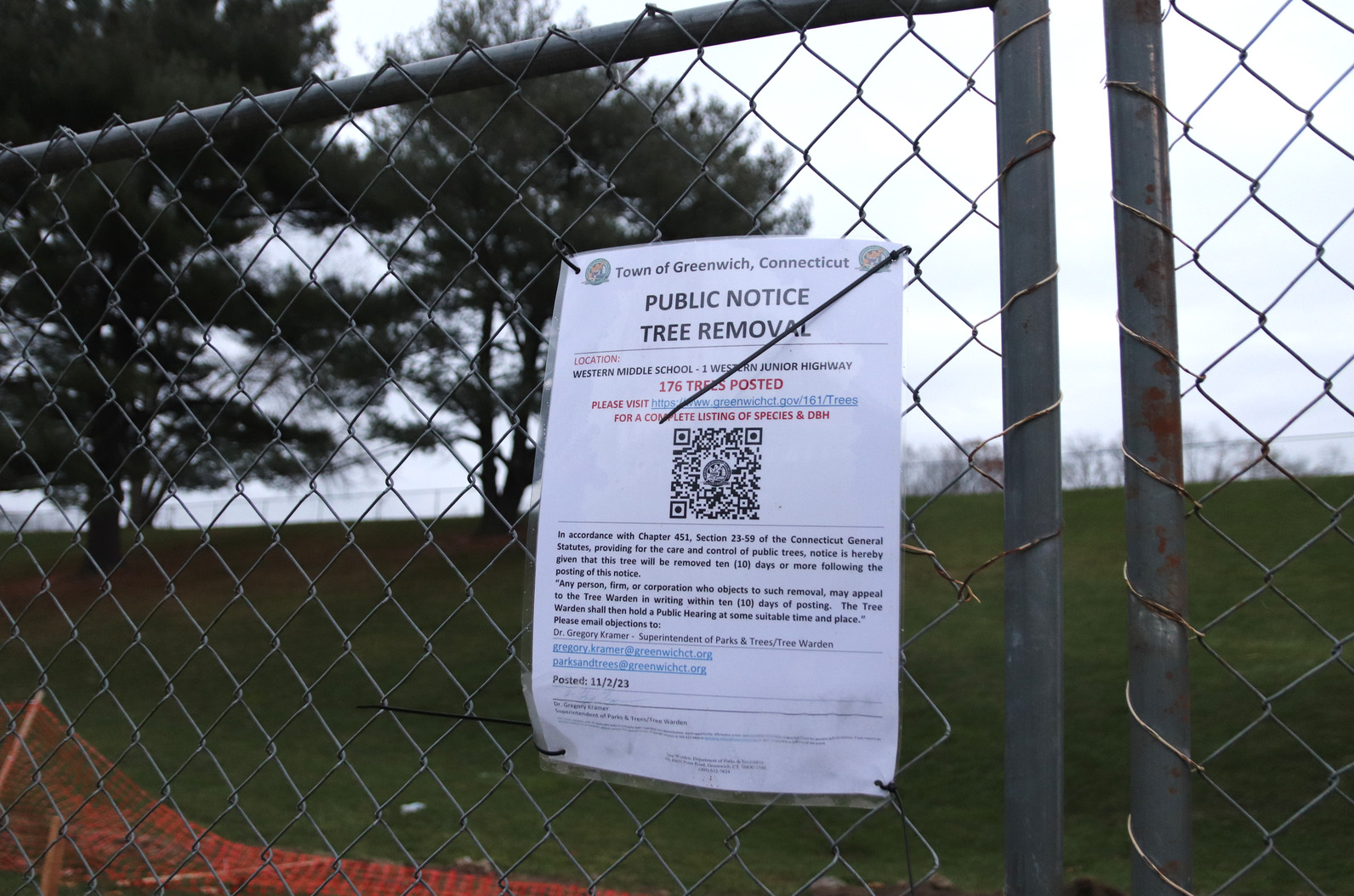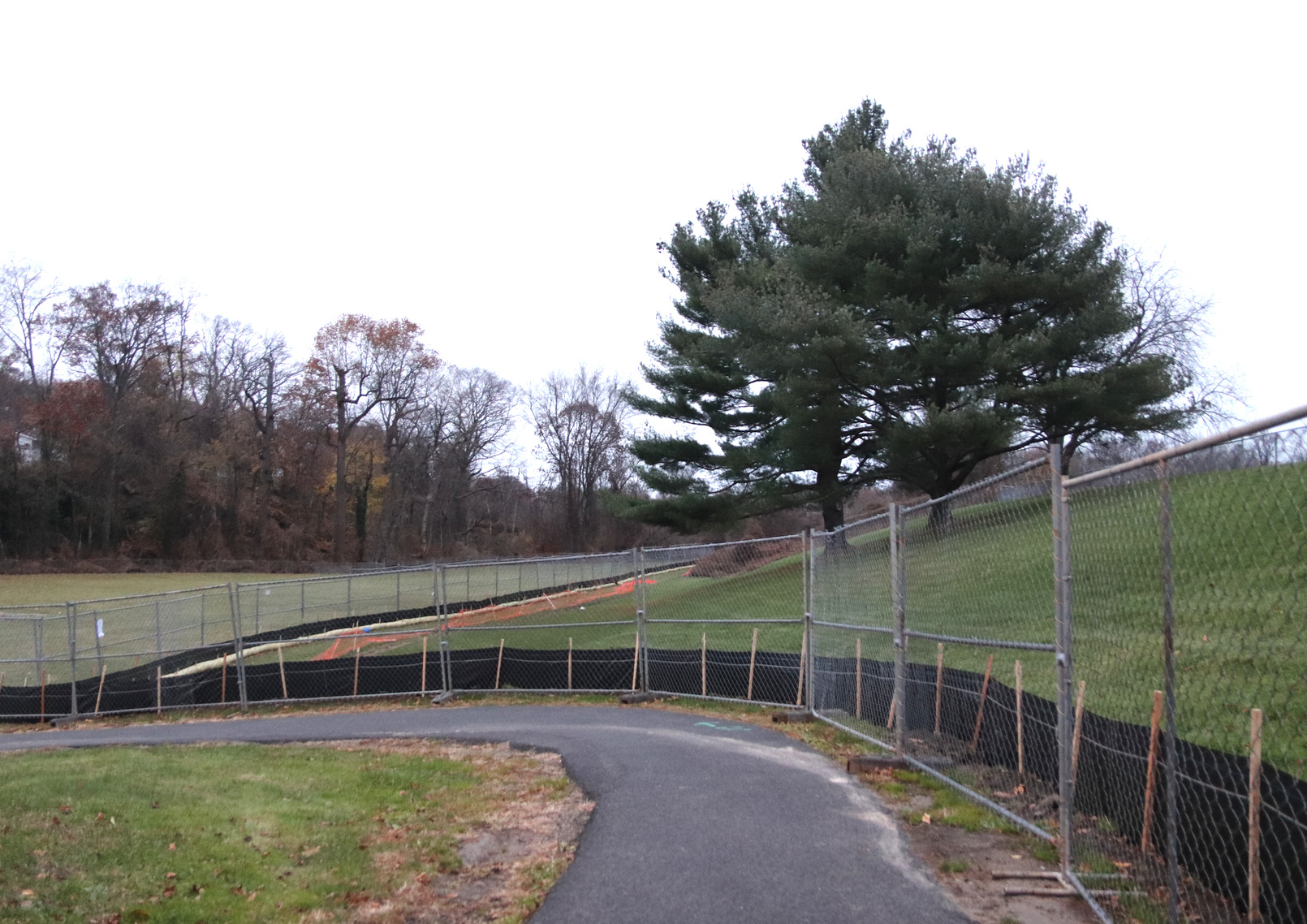Dozens of parents testified during Thursday’s public tree hearing about fate of 176 trees posted by town tree warden Dr. Greg Kramer for removal at Western Middle School.
The trees are in contaminated soil in the school’s fields that are slated for remediation.
Landscape architect for Langan Joe Bini said the planting plan was about the restoration of an eco system. Most of the trees to be removed are around the perimeter of the field. Some of the 176 trees being removed include invasive species (35%) trees below 4″ DBA (23%) or in poor or dead condition (20%).
The largest categories of trees being removed are Norway Maple, Black Cherry, Ailanthus (“Tree of Heaven”) and Black Locust.
5 Primary Objectives of the Landscaping Plan
1. Reintroducing native species and restoring the tree canopy
2. Providing seasonal interest. Since school is in session fall through spring so this might be achieved through flowers in the spring or interesting colored bark in the winter time
3. Improving wildlife habitat by bringing in species with berries, different fruits or nuts – wildflowers or pollinator species – where may not be some today
4. Implementing a “Successional Landscape.” From bear earth to full grown shade tolerant trees takes place over generations, but the project will give a kick start. By planting at different sizes avoids creating a monoculture on day one. Over time certain species may take over, some may die back
5. Cost effective long term solutions. A meadow is proposed for the northern portion of the site. Meadows are cost effective, but promote wildlife habitat and different pollinaor species.
Three zones
At the bottom (east side of property) of the diagram the Restoration zone the plan it ultimately to restore the high density woodlands. This will provide a “green filter” and will include shrubs
At the right is the Transition zone, where they plan the native seed mix for a transition and a passive landscape, not intended for people to be in but rather for habitat
The Education zone will serve as an extension of the basketball courts and the hill area where children will play. They will plant larger shade trees and lawn here for informal learning.

Three Zones. There will be fencing around the perimeter of the playing fields, but not between the pathway and the landscaped areas.
Tree Quantities
• 214 full size tree replacements (2 inch to 5 inch caliper)
• 844 restoration size tree species, which are smaller plantings which go in at a 2-3 ft height but over time will grow to a full Oak or Maple Tree.
• 1058 total replacement quantity, for nine times the amount of trees being removed, include native trees, understory trees, evergreen trees
From the time the vegetation is planted – all trees and shrubs – they are guaranteed for two years. If they don’t survive, they have to be replaced.
Public Comment
In addition to numerous parents, BOE members Laura Kostin and Karen Hirsh, as well as WMS principal Dr. Wax shared their support.
Everyone supported the planting and remediation plans, but lamented that the fields had been out of use since 2016 and enumerated impacts on so many students.
Several people noted that they were required to identify themselves by name and address while the identity of the person who was the “objector” to the trees being removed had not been released.
No one testified in objection to the tree removal during the hearing.
JoAnn Messina, director of the Greenwich Tree Conservancy, said the situation underlined how critical it was to involve the tree warden early in the process, and praised Dr. Kramer for having used his own department budget to hire a company to do a tree inventory.
But, she said, “Due diligence should have been done by the Board of Education.”
The good news, she said, was that the result of Dr. Kramer’s involvement was a significant reduction in the number of trees to be cut down.
“I hope it will be done in the future with our school projects because we really need this tree canopy for our students,” she said. “Specifically, the western part of the town has a much smaller tree canopy.”
Next Steps
The tree hearing was triggered by the objection of one Connecticut resident, but that person’s identity was not shared.
Dr. Kramer was asked about next steps – especially, given the identity of the objector had not been shared, what the objector might do if the tree warden approved the removals.
Dr. Kramer explained that per state statute he had up to 3 business days to issue his decision on the fate of the trees.
The decision letter will be available to the public by Tuesday.
From there, regardless of whether or not Kramer rules to approve the tree removals, his decision can be appealed by an objector, within 10 days, to State Superior Court in Stamford, which would delay the entire project.
“In all fairness, the state statute provides for any resident in Connecticut to object to vegetation removal,” Kramer said. “That is due process.”

Tree removal notice attached to fencing along the field areas where trees are proposed to be removed. Nov 26, 2023 Photo: Leslie Yager
Delays and Due Process
One commenter pointed out that going into winter, the weather could delay the project.
Clare Kilgallen asked about the time it took to tag the trees. She asked why the trees weren’t posted for removal four months earlier when P&Z rendered their decision to approve the WMS application.
After Thursday’s hearing, Kramer responded to an email asking for the identity of the objector and for the reason for the four month delay.
Dr. Kramer said an FOIA request was required for the identity of the objector.
GFP immediately sent the question again as an FOIA request.
On Friday morning, Dr. Kramer’s office replied with the original objection, which was from Armando Grijalba on Nov 2, 2023.
As for the delay in tagging trees, Kramer replied, “After the P&Z approval process I noted to Langan that there needed to be delineation between the trees to be retained and the trees to be removed prior to any tree postings.”
“I requested orange construction fencing be installed,” he added. “As these are large areas with many trees, individual tree posting would not work. The fencing would provide the visual extent to anyone interested of trees to be removed and trees to be retained. Along with the fencing actual posters (were) placed every so often. In essence it took longer on the construction side.”
See also:
P&Z Balks at Rink Proposal: Cost is Not Our Purview, Greenspace Is Nov 30, 2023
Tree Hearing to Reveal “High Quality and Tree-Friendly Design” at Western Middle School Nov 27, 2023

Fencing of field areas where trees are proposed to be removed. Nov 26, 2023 Photo: Leslie Yager